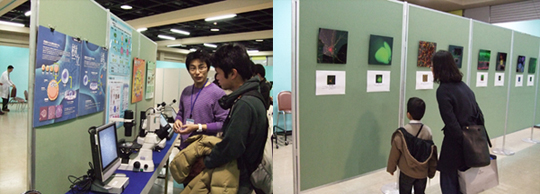| Kagaku Ichiba |
 |
 |
March 20, 2010 – On February 28, the RIKEN CDB jointly organized a science exchange event, “Kagaku Ichiba,” with the Kobe Science Museum where it was held. This event, supported by a grant from the Japan Science and Technology Agency (JST), was held in an effort to promote science to the general public and attended by people of all ages.
The day featured a series of different events, beginning with a lecture in the morning by CDB scientist Kinya Ota of the Laboratory for Evolutionary Morphology (Shigeru Kuratani; Group Director) who engaged the audience with a talk about his research on hagfishes, a jawless vertebrate, and their appeal for research on evolution. For those with a hankering to see hagfishes with their own eyes, preserved samples of were available for viewing, along with other model organisms used in research, such as African-clawed frogs, turtles, and planarians, in the main event space. Visitors also had the opportunity to peer through the microscope to look at mouse embryonic stems cell and iPS cells, and young CDB researchers and students were on hand to explain scientific concepts and answer any burning biology-related questions, from DNA to stem cell research, on the mind of the visitors. Scientists from the Laboratory for Retinal Regeneration (Masayo Takahashi; Team Leader) collaborated with a non-profit organization Kobe Eyelight Association that assists people with low-vision (LV) to promote awareness about LV and introduce the innovative research going on to help people with low-vision (LV). Visitors were also able to experience different LV conditions and see some of the technology developed to help LV patients in their daily lives.

|
In the afternoon, a science café brought together scientists and non-scientists to discuss their views on the topic, “Can iPS cells change medicine? – reflecting on the future led by regenerative medicine.” This session was organized as part of a joint research project between Osaka and Kyoto University called DeCoCis (Deliberation and Cooperation between Citizens and Scientists; a group of scientists and citizens that work together to address science and technology-related societal issues).
One of the highlights of the Kagaku Ichiba was a photo exhibit was set up in a corner of the main event space showcasing beautiful scientific images of cells and DNA, etc. that were captured though the microscope by CDB researchers, demonstrating that science itself can be pieces of art. Another popular event was the hands-on LED craft sessions where participants could build LED light circuits while learning more about LED lights and what makes them more efficient than regular light bulbs.
|